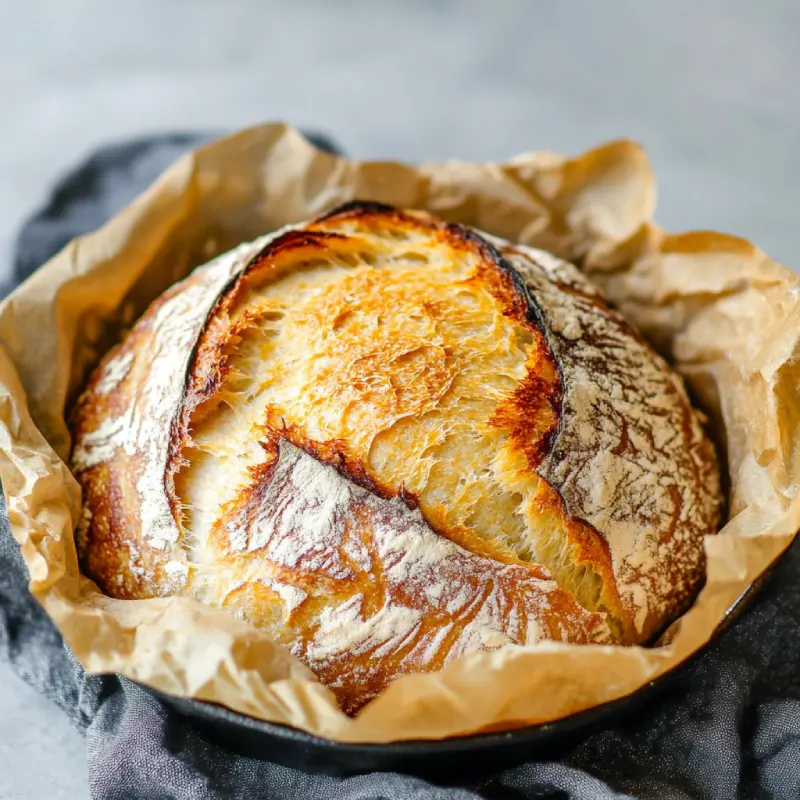Introduction and Understanding Sourdough Bread
Sourdough bread has gained immense popularity in recent years, cherished for its unique flavor, chewy texture, and artisanal qualities. Unlike commercially produced breads, sourdough is made through a natural fermentation process that relies on wild yeast and bacteria, giving it that distinctive tangy taste. This method not only enhances the flavor but also improves the bread’s digestibility and shelf life.
For many home bakers, the thought of making sourdough can seem daunting, especially with the need for a starter, which requires time and care to cultivate. However, making sourdough without a starter is entirely possible and can be a great introduction to the world of sourdough baking. By using simple ingredients and allowing the natural fermentation process to take place, you can create delicious sourdough bread at home.
What is Sourdough Bread?
Sourdough bread is a type of bread made through a natural fermentation process that utilizes wild yeast and lactic acid bacteria. This method sets it apart from commercially yeasted breads, resulting in a unique flavor profile and texture. Characterized by its chewy crust and soft, tangy interior, sourdough bread has a distinctive sour taste, which comes from the fermentation process.
The Role of Wild Yeast and Bacteria in Fermentation
Wild yeast and bacteria thrive in the environment and are naturally present in flour and air. During the fermentation process, these microorganisms break down sugars in the dough, producing carbon dioxide and organic acids. This not only leavens the bread but also contributes to its complex flavors and improves its digestibility. The natural fermentation process makes sourdough bread a healthier option compared to standard bread.
Benefits of Making Sourdough Without a Starter
Making sourdough without a starter offers several advantages:
- Convenience of Skipping the Starter Preparation:
Traditional sourdough recipes require a starter that needs to be fed and maintained over time. By omitting this step, you can simplify the process. - Time-Saving Aspects for Beginners:
Without the need to cultivate a starter, beginners can dive straight into baking. This reduces the intimidation factor associated with sourdough baking. - Accessibility for Those Without Prior Experience:
Making sourdough without a starter allows anyone to experience the joy of baking homemade bread, regardless of their baking background.
Key Ingredients for Sourdough Bread
To create a delicious sourdough bread, you’ll need a few essential ingredients:
- Flour: The backbone of your dough. Bread flour or all-purpose flour works well, but using 00 flour can yield a chewier texture.
- Water: Essential for hydrating the flour and activating the fermentation process.
- Salt: Enhances flavor and helps strengthen the dough.
Importance of Using High-Quality Ingredients
Using high-quality ingredients is crucial for achieving the best flavor and texture. Fresh flour and filtered water can significantly impact the final product.
Optional Ingredients for Flavor Variations
- Herbs: Add dried or fresh herbs like rosemary or thyme for an aromatic twist.
- Seeds: Incorporate seeds such as sesame or sunflower for added crunch and nutrition.
Understanding the Fermentation Process
Fermentation is a key aspect of sourdough baking, even when not using a starter.
Overview of Fermentation Without a Starter
In this method, you rely on the natural yeast present in the flour and the environment to ferment the dough. The process begins when the dough is mixed and allowed to rest, allowing wild yeast to grow.
How to Cultivate Wild Yeast from the Environment
- Use High-Quality Flour: Whole grain flours often contain more wild yeast, making them ideal for fermentation.
- Allow for Ambient Fermentation: Simply mixing the dough and letting it sit can invite wild yeast to populate the dough.
Importance of Patience in the Fermentation Process
Fermentation takes time; typically, you’ll need to allow the dough to rise for several hours or overnight. Patience is essential for developing the flavors and achieving the right texture.
Step-by-Step Sourdough Bread Recipe Without Starter
Making sourdough bread without a starter is an accessible way to enjoy homemade bread with that signature tangy flavor. Here’s a detailed guide to help you create your own delicious loaf.
Ingredients Needed
- 3 ½ cups bread flour (or all-purpose flour)
- 1 ¼ cups lukewarm water
- 1 teaspoon active dry yeast
- 1 ½ teaspoons salt
- 1 tablespoon sugar (optional, helps with fermentation)
Detailed Instructions for Making the Dough
- Activate the Yeast:
In a small bowl, combine 1 ¼ cups of lukewarm water and 1 teaspoon of active dry yeast. If using, add 1 tablespoon of sugar to help activate the yeast. Let it sit for about 5-10 minutes until it becomes frothy. - Mix Dry Ingredients:
In a large mixing bowl, whisk together 3 ½ cups of flour and 1 ½ teaspoons of salt. This ensures the salt is evenly distributed, which is crucial for dough strength. - Combine Wet and Dry Ingredients:
Pour the yeast mixture into the flour mixture. Stir with a wooden spoon until a shaggy dough forms. You might need to adjust the flour or water slightly to achieve the right consistency. - Knead the Dough:
Transfer the dough to a lightly floured surface. Knead for about 8-10 minutes until it becomes smooth and elastic. The dough should be slightly tacky but not overly sticky. - First Rise:
Shape the dough into a ball and place it in a lightly oiled bowl. Cover with a damp cloth or plastic wrap. Let it rise in a warm place for about 1 to 1.5 hours or until it doubles in size.
Tips for Achieving the Right Consistency and Texture
- Hydration Level: The dough should feel slightly tacky but manageable. If it’s too sticky, sprinkle a little flour during kneading.
- Use Bread Flour: This type of flour has a higher protein content, which helps develop gluten and gives your bread a better structure.
Recommended Resting and Fermentation Times
- First Rise: Allow the dough to rise for 1 to 1.5 hours in a warm, draft-free area. You can also let it rise overnight in the refrigerator for enhanced flavor.
- Shaping and Second Rise: After the first rise, gently punch down the dough to release excess air. Shape it into a round or oblong loaf, then let it rise again for about 30-45 minutes.
- Preheat the Oven:
While the dough is resting, preheat your oven to 475°F (245°C). If you have a baking stone or Dutch oven, place it in the oven to heat up. - Score the Dough:
Just before baking, use a sharp knife or bread lame to make shallow slashes on the top of the dough. This helps control how the bread expands in the oven. - Bake the Bread:
Transfer the dough onto the preheated stone or into the Dutch oven. Bake for about 25-30 minutes, or until the crust is golden brown and the internal temperature reaches 200°F (93°C). - Cool the Bread:
Once baked, remove the bread from the oven and let it cool on a wire rack for at least 30 minutes before slicing. This allows the crumb to set properly.
Enjoy the delightful process of making your own sourdough bread without a starter! The aroma of fresh-baked bread filling your home is truly rewarding.
Shaping and Baking the Bread
Once your sourdough bread dough has completed its second rise, it’s time to shape and bake it to perfection. Here’s how to do it!
Instructions for Shaping the Dough into a Loaf
- Prepare Your Surface:
Lightly flour a clean work surface to prevent sticking. - Gently Turn Out the Dough:
Carefully turn your risen dough onto the floured surface. Avoid deflating it too much to retain air bubbles. - Shape the Dough:
- For a Round Loaf: Gently stretch the edges of the dough towards the center, tucking them underneath to form a tight ball.
- For a Long Loaf: Flatten the dough into a rectangle and fold the shorter edges toward the center. Roll it up tightly from one end to the other.
- Final Proofing:
Place the shaped dough seam-side down in a floured proofing basket or bowl. Cover with a damp cloth and let it rise for another 30-45 minutes.
Tips for Preheating and Using Baking Vessels
- Preheat Your Oven:
Preheat your oven to 475°F (245°C) at least 30 minutes before baking to ensure it reaches the desired temperature. If using a Dutch oven, place it in the oven to heat up as well. - Baking Vessels:
A Dutch oven is ideal for baking sourdough as it creates a steamy environment, which helps achieve a crispy crust. Alternatively, you can use a baking stone or a cast-iron skillet.
Baking Times and Temperatures for Perfect Crust
- Baking Time:
Bake the loaf for 25-30 minutes. If using a Dutch oven, you can remove the lid for the last 10-15 minutes to allow the crust to brown further. - Check for Doneness:
The bread is done when it’s golden brown and sounds hollow when tapped on the bottom. For best results, aim for an internal temperature of 200°F (93°C).
FAQs About Sourdough Bread Without Starter
Here are some common questions about making sourdough bread without a starter:
- Can I use all-purpose flour instead of bread flour?
Yes, you can use all-purpose flour, but bread flour will yield a chewier texture due to its higher protein content. - How long does the dough need to rise?
The first rise typically takes 1 to 1.5 hours, and the second rise takes about 30-45 minutes. This may vary based on room temperature. - What if my dough isn’t rising?
If the dough doesn’t rise, it may be due to inactive yeast. Ensure your yeast is fresh and that the water used is lukewarm (not too hot or cold). - Can I add herbs or seeds to the dough?
Absolutely! Adding herbs, seeds, or other flavorings can enhance the bread’s taste. Just incorporate them during the mixing phase.
Conclusion
In summary, making sourdough bread without a starter is an accessible and rewarding process that allows you to enjoy homemade bread with minimal fuss. By following the steps outlined in this recipe, you can achieve a delicious loaf that showcases the unique flavors of sourdough. We encourage you to try baking this bread at home and to experiment with different variations and ingredients. Happy baking!

